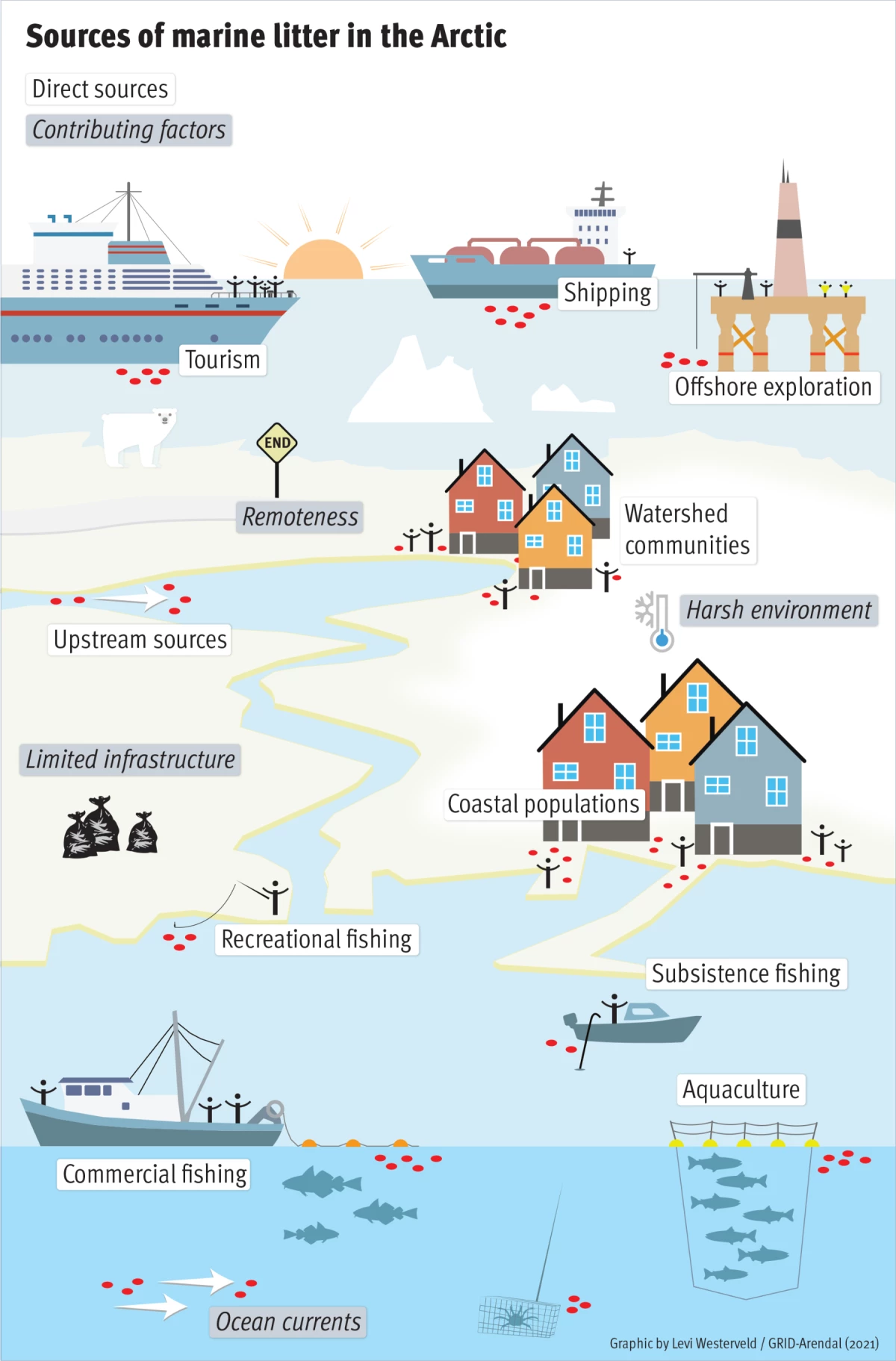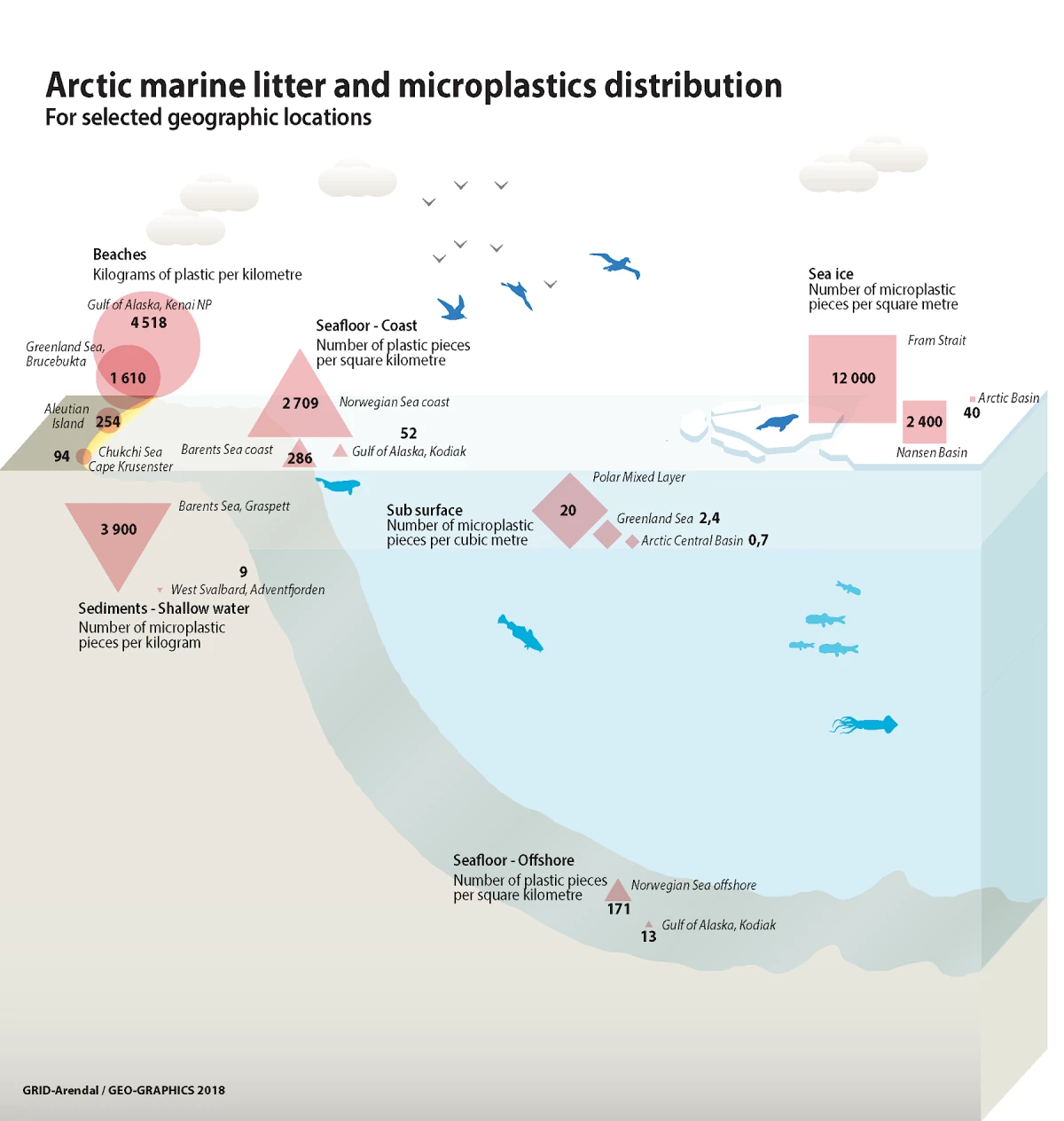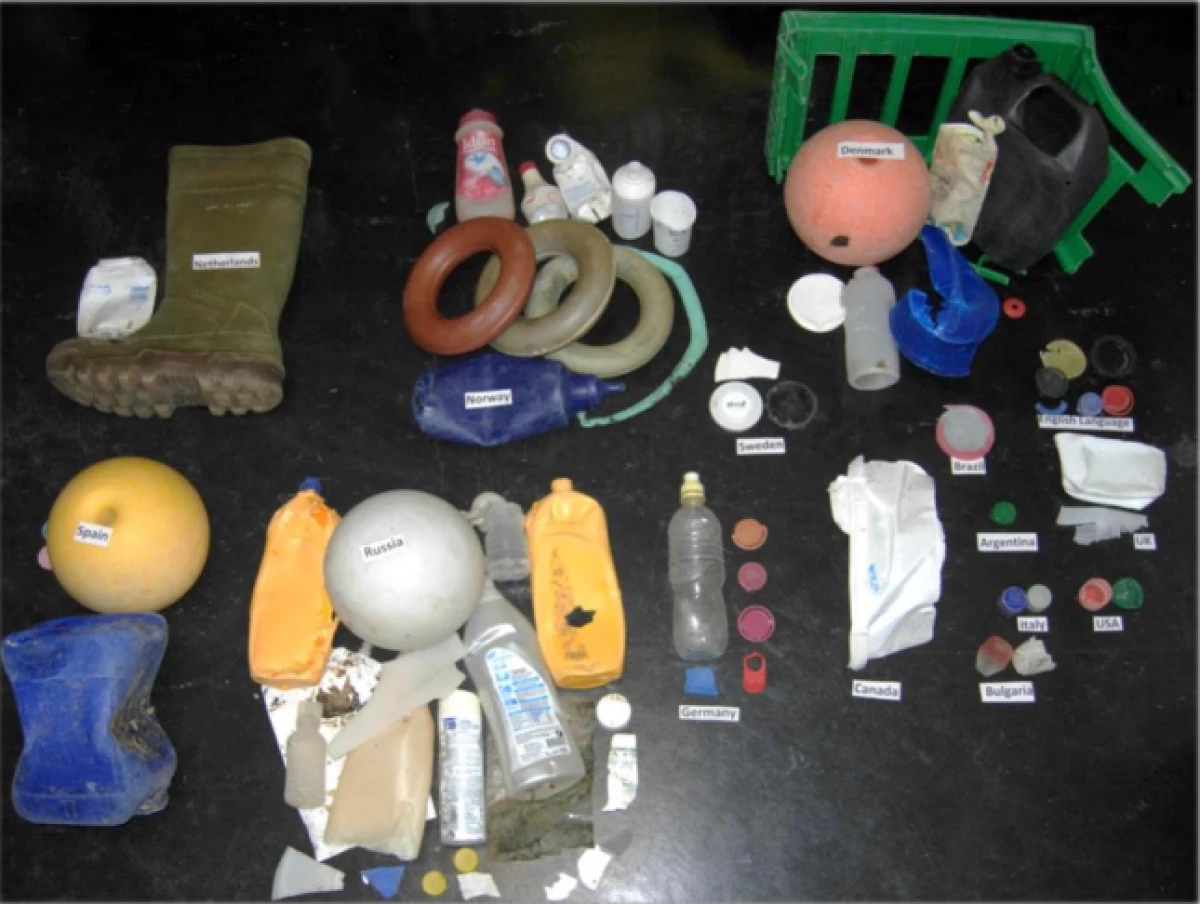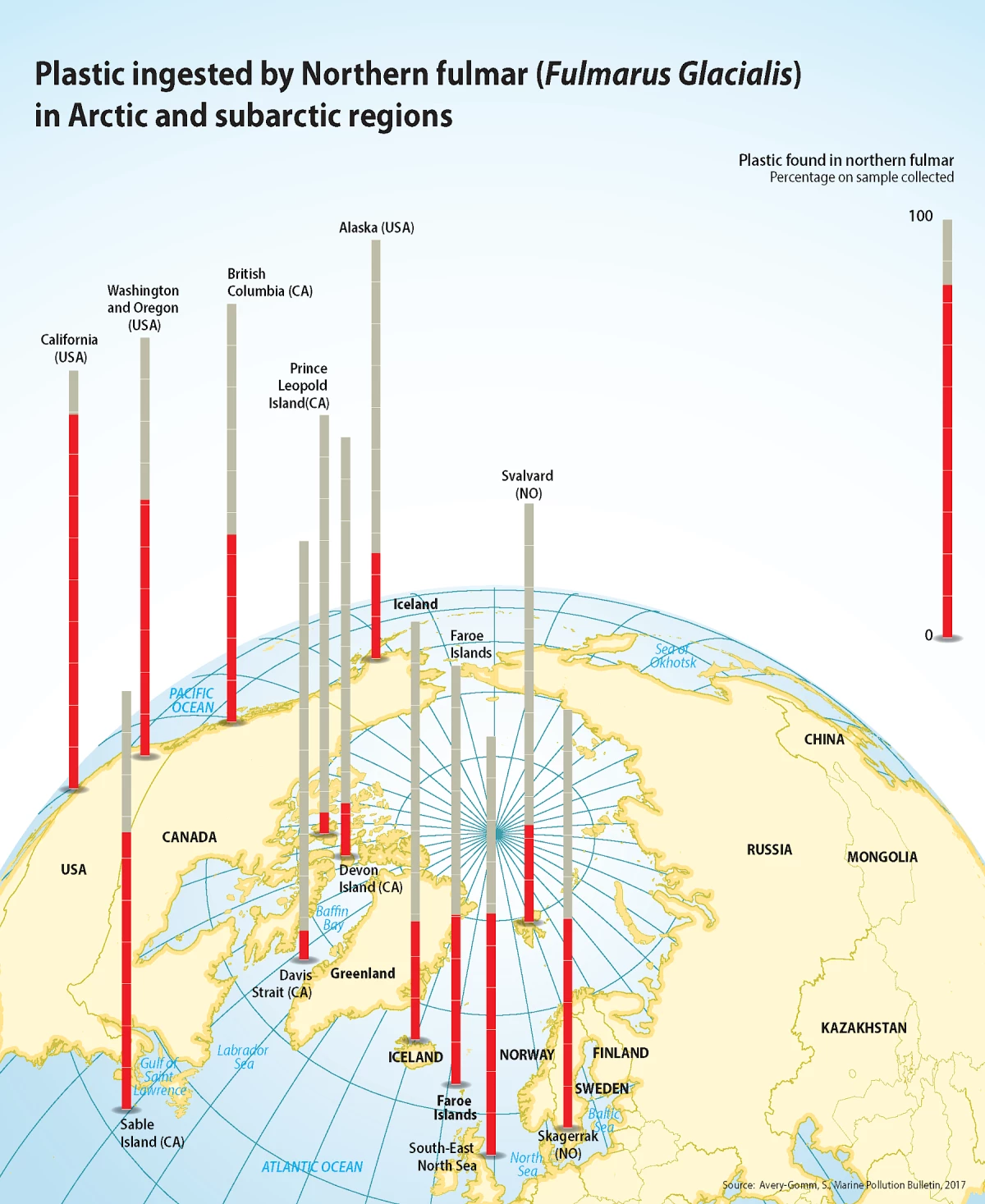Arctic Marine Litter
Marine litter, particularly marine plastic litter, is amongst the most pervasive problems affecting the marine environment globally.
Marine litter, also known as marine debris, has been defined as “any persistent, manufactured or processed solid material discarded, disposed of, or abandoned in the marine and coastal environment”. Examples may include all types of plastic, including microplastics, machined wood, synthetic fiber, textiles, metal, glass, ceramics, rubber and other persistent artificial material.
Research summarized within PAME's Desktop Study on Marine Litter in the Arctic highlighted that marine litter is found across the Arctic marine environment, including in sea ice, seafloor sediments, throughout the water column, and on coastlines. Marine litter affects Arctic wildlife in a range of ways, including ingestion and entanglement. It can also damge habitats, serve as a means to transport non-native species, and abosorb or release contaminants in the environment.
The presence of marine litter in the Arctic marine environment is connected to human activities occurring both within and outside the Arctic region.
Marine litter is a threat not only to marine species and ecosystems, but also to human health. It also has significant implications for human welfare, negatively impacting vital economic sectors such as tourism, fisheries, and aquaculture, and bringing economic losses to individuals, enterprises, and communities.
While the serious threats that marine litter poses to the marine environment and human welfare are globally recognized, the Arctic is a region with unique geographic, climatic, biological and cultural characteristics, as well as unique geopolitical context.
PAME's Work on Marine Litter
- Desktop Study On Marine Litter í the Arctic (2019)
- To better understand the state of knowledge of marine litter in the Arctic.
- Regional Action Plan (2021)
- To support Arctic States’ efforts to reduce marine litter, prevent negative impacts and mitigate risks, and improve cooperation and awareness.
- Plastic in a Bottle: Live Map (Continous)
- Highlightong how litter travels to and from the Arctic
- ALDFG (Ongoing)
- To enhance understanding of Abandoned, Lost or otherwise Discarded Fishing Gear.
- Coastal Cleanup
- To remove litter from Arctic beaches and waterways.
- Marine Litter Symposiums
- To
Sources of Marine litter in the Arctic

Marine litter, including microplastics, has been observed in all environmental compartments across the Arctic marine environment (Figure III.3 below). Even in some locations distant from hubs of human activity, marine litter abundance is within the same order of magnitude to that of populated areas close to urban centers (Hallanger and Gabrielsen, 2018). It is important to note that the geographic distribution of documented observations of marine litter, including microplastics, is heavily dominated by higher accessibility and increased research activity in the Atlantic Arctic (Norwegian, Greenland and Barents Sea), as well as in the Bering Sea and the Gulf of Alaska and their coastal areas. Compositionally speaking, data regarding materials other than plastic is only available for beach and sea-floor surveys, as sea ice, surface waters, water column, and sediment studies have only focused on the concentration of plastic litter and microplastics.

Composition
The Desktop Study reviews multiple studies on litter on beaches in the Arctic. For example: "In the OSPAR maritime area of the North-East Atlantic region, beach litter is monitored at 17 sites within the Atlantic Arctic, with 36 surveys conducted in 2017.... Plastic accounted for up to 94% of the material in the spring surveys (OSPAR. Pers. Comm.)."
The photo to the right shows litter found on Svalbard on the Hinlopen Strait. "A close inspection of litter beached on Svalbard showed that the majority of litter items with identifiable imprints originated from Norway and Russia (41%), other European countries (43%), or other sources including Canada, USA, Brazil, Argentina (9%) (Bergmann et al., unpubl. data, Figure III.2)."
"Still, it is important to bear in mind that the identification of the country of production of an object does not mean that the actors involved in the release are also from the same country as the object could have been internationally traded. Similarly, and also very important, the country of production of an object does not indicate where the object has been released, as it could have been transported for long distances before being released in the environment."

The Desktop Study furthermore discusses applicable governance frameworks, literature reviews on sources and drivers, pathways and distribution, interactions with biota and impacts and monitoring and response. It also identifies knowledge gaps, main findings and next steps.
Plastic in Fulmars
Research on seabirds, in particular northern fulmars (Fulmarus glacialis), prevails amongst other groups of organisms due to their widespread recognition as biological indicators of levels of pollution, distribution across the northern Hemisphere, allowing for standardized comparisons to be made and their high vulnerability to plastic ingestion due to their feeding habits.
According to some studies the residence time of plastic in the gastro-intestinal tract of northern fulmars is short, with 75% of the plastic ingested being passed from the stomach to the gut within a month (van Franeker and Law, 2015). If this is so, plastic in the stomach contents of northern fulmars is a relatively robust indicator of local pollution levels. If sampling is carried out shortly after migration, the amount of plastic in the stomach contents may be an indicator of plastic pollution in their foraging areas along their migratory pathway, but this will not mask the trends in multiyear datasets of geographically distinct regions (van Franeker et al., 2011; Trevail et al., 2015b).
Some caution should still be used when interpreting plastic ingestion data, as the inference of environmental conditions based on plastic stomach contents has been a subject of discussion, and accurate measures of ingested plastic retention times are needed to better understand temporal and spatial patterns in ingested plastic loads within marine organisms (Ryan, 2015b).
In addition, O'Hanlon et al., 2017 conclude in their review of the incidence of marine plastic debris in seabirds of the northeastern Atlantic that opportunistic sampling with limited or no
coordination precludes the identification of temporal and spatial trends and therefore, the apparent trends derived from our review should be considered cautiously.
The stomach contents of northern fulmars have been the focus of a special project for the monitoring and assessment of plastic particles in the North Atlantic developed within the OSPAR Ecological Quality Objectives (EcoQOs) (OSPAR Commission, 2008; van Franeker and The SNS Fulmar Study Group, 2013; OSPAR Commission, 2015) and have also been established as an OSPAR Common Indicator. The methodology initially developed for monitoring the incidence of plastic pollution in the North Sea is now being used for the areas of the eastern North Atlantic, the western North Atlantic and of the North Pacific where northern fulmar is found. This includes observations within the Arctic region, thus allowing relevant comparisons within and across the Arctic. Some of the most recent examples of such extensive comparisons, including data from within and outside the Arctic region, are included in the works of Trevail et al., 2015a; van Franeker and Law, 2015; Avery-Gomm et al., 2017; Provencher et al., 2017; and van Franeker, 2017.

The latest comparison of standardized plastic content in northern fulmars (Avery-Gomm et
al., 2017) (Figure III.6), which added data from the Labrador Sea to the existing dataset,
further corroborates the northwards decreasing trend in plastic contents in the Eastern North
Atlantic, Western North Atlantic and Eastern North Pacific (Kuhn and van Franeker, 2012).
Therefore, northern fulmars foraging in the Arctic contain less plastic in comparison with
those which breed and forage closer to highly developed and populated areas further south
(e.g., comparative studies of Day et al., 1985; Provencher et al., 2014; Trevail et al., 2014;
Amelineau et al., 2016; Avery-Gomm et al., 2017). Out of the three regions, the Arctic areas
north of the Eastern North Atlantic (Barents and Greenland Seas) are characterized by much
higher levels of plastic presence in northern fulmars than in areas at the same latitude or
further south in the Eastern North Pacific (Gulf of Alaska) and the Eastern North Atlantic
(Northwest Passage).
 Arctic Council Working Group
Arctic Council Working Group